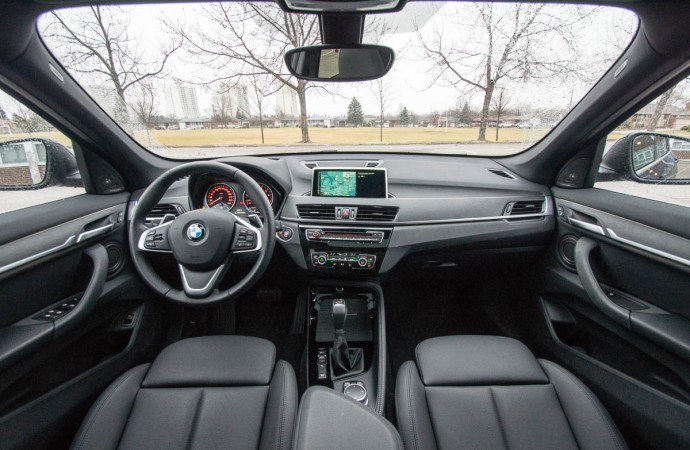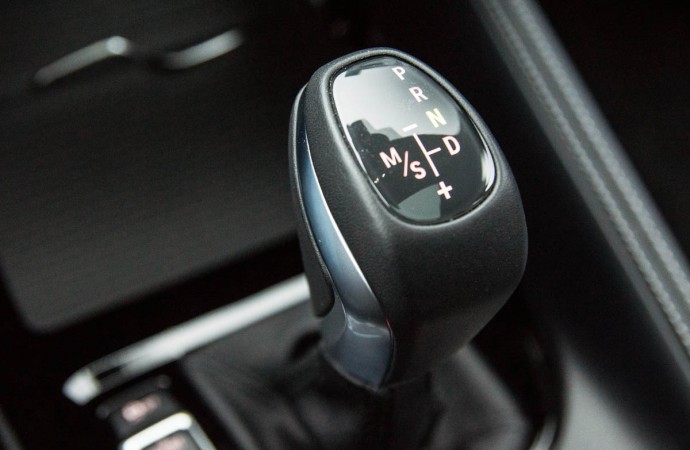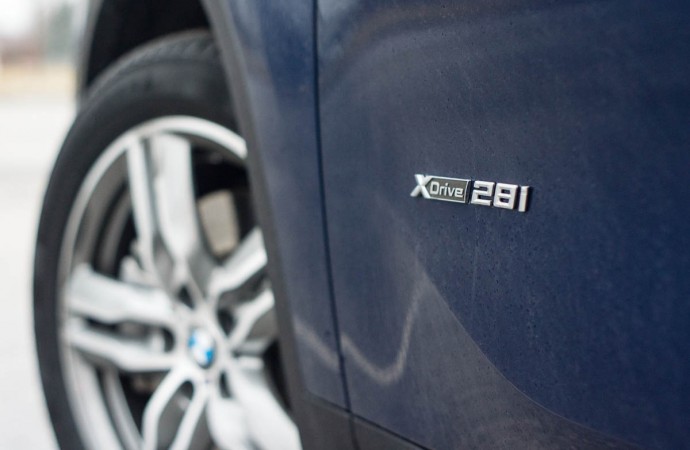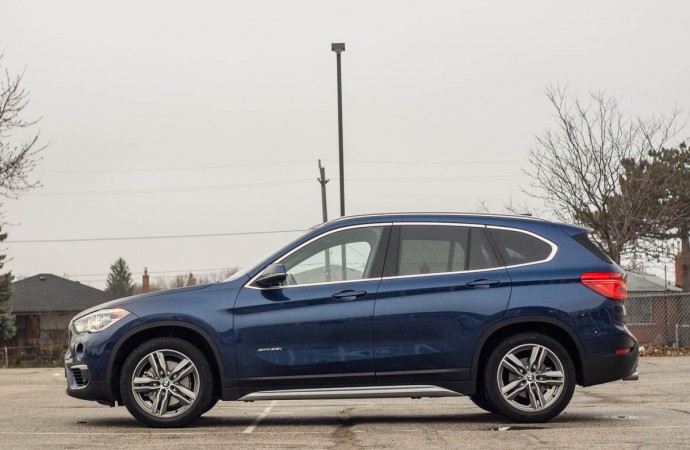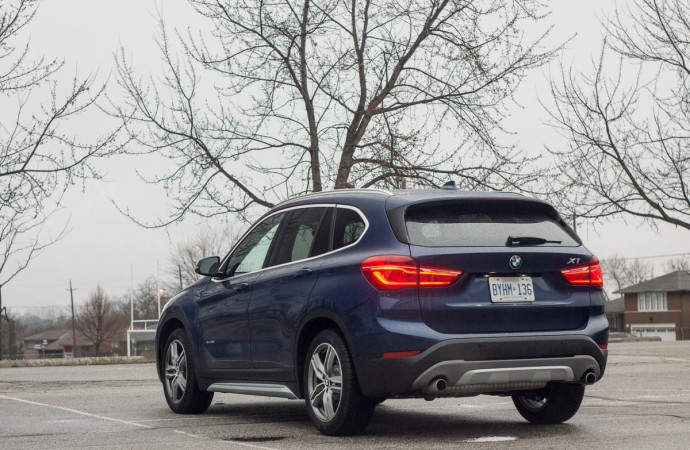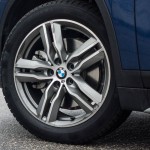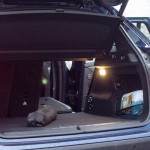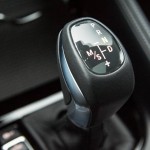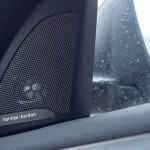Compact luxury crossover utility vehicles (CUVs) are a hot commodity these days, now that people are realizing they don’t necessarily need to be in a mid-sized or even full-sized truck to get the premium feel and brand cachet that everybody is looking for nowadays. Cars like the BMW X5 and X3 have long been strong sellers, but like all cars these days, are getting bigger and bigger. This allows vehicles like this 2016 BMW X1 xDrive28i to serve as the entry-level option to BMW’s X-series vehicles. I’m not suggesting that the X1 is a new product – it isn’t – but I think the one thing that kept it away from greater success was its slightly awkward looks.
The 3-Series Touring station wagon is exactly what you think it is – a station wagon. The first-generation X1, on the other hand, is a little different. While it shares most of its underpinnings with the 3-Series, its jacked up proportions gives it more of a tall-wagon look, rather than a small luxury CUV look that I think BMW was originally going after. The first-generation X1 was probably most awkward in the way its front-end looked. The headlights were considered by many to be just a little too big, and out of proportion to the rest of the vehicle. The side profile is typical wagon – while it was something I didn’t mind, the crowd seemed to gravitate to the X3 for its more typical CUV proportions. The redeeming feature of the first-generation X1 is the fact that it borrowed its powertrain from the 3-Series. More on this later.
The big deal with the new 2016 BMW X1 xDrive28i is that it isn’t anything like the model it replaces. The big news here is that the 2016 X1 is now much closer to the Mini Countryman than a traditional BMW. This makes the X1 the only vehicle in BMW’s current North American lineup that features a transversely-mounted four-cylinder engine (the old X1 featured a longitudinally-mounted engine). I found the original X1 endearing because of the availability of its hot 35i-series turbocharged six-cylinder engine. 300hp in a silky-smooth package was nothing to scoff at. This powertrain is no longer available, unfortunately. Will this drastic change in architecture make the X1 less interesting? Will it feel like a Countryman in a different skin? I picked up a Mediterranean Blue Metallic X1 xDrive28i to find out.
The biggest change to the X1 has to be its appearance. No longer is it slightly awkward and dorky, it now features proportions much more in-line to what people are accustomed to, when it comes to the small premium crossover utility vehicle. BMW, in their infinite wisdom, still calls the X1 a SAV – short for Sports Activity Vehicle). I would go as far as saying it’s an attractive design, as far as BMW SUVs go, but I can’t help but see a little bit of Mazda CX-5 and even Hyundai Santa Fe in the side profile. There isn’t much in the way of the traditional BMW “Hofmeister Kink” (like on the X5), but other BMW traits, like the short overhangs remain.
The headlights speak the new BMW design language, and feature LED daytime running lights. Out back, the glossy “Air blades” that flank the rear window improve aerodynamics and add help visually reduce the thickness of the C-pillar. LED light pipes integrated into the taillights are nice and bright, and they look great. Overall, it’s a much more mainstream (and current) design that should help it stay in the minds of prospective customers. One little detail that I thought was interesting: this X1 xDrive28i features one exhaust tip on each side of the car, somewhat like the 35i-series vehicles elsewhere in the BMW family. Typically, on 28i-series vehicles, there would only be two exhaust tips together, on the left side of the rear apron.
Inside, the X1 stays true to BMW’s current design themes, but like the exterior, updates a few items here and there to bring it up to today’s standards. In front of the driver, remains BMW’s steering wheel, paddle shifters, and traditional gauge cluster. My particular tester featured the Premium Enhanced package, which includes a whole slew of items: heated steering wheel, power rear liftgate, comfort keyless access, panorama sunroof, heads-up display, and onboard navigation, among other items. It’s a package that I feel a lot of people will select, because of all the “essentials” included within. The unfortunate thing here is that it’s a good way to instantly add $4,950 to the bottom line.
The X1, with this package, is obviously very well-equipped. What I like about it are the little details. Real open-pore wood inserts adorn the interior and provide a very premium feel. Visibility for the driver is surprisingly good, with low sills around the side mirrors. There’s a good sense of overall quality, and nothing in the interface really stands out in a negative way. The family link to the Mini Countryman is more apparent once you start looking around inside the X1.
The shifter is not shared with any other BMWs, but is borrowed (and tweaked slightly) from the Countryman. The next giveaway is how low the iDrive controller and centre console are. This trait is touted by Mini to increase overall interior space, but makes the X1 feel a little different compared to cars like the 3-Series, with its higher centre console. Thanks to its front-drive powertrain setup, accommodations are surprisingly good, with decent headroom and legroom for four. Even better – the second row can slide forward and backward, as well as recline, good for those times where you need to prioritize passenger space or cargo space. The X-Series of BMW crossovers have always done a good job of being useful in many ways (maybe save for the X6, which has different priorities), and the X1 is no exception. For improved visibility when you’re not carrying passengers in the second row, you can fold down those headrests.
The X1 is only available in the xDrive28i model designation – there’s no xDrive35i anymore, like with the original X1. The big change is the aforementioned move to a transversely-mounted powertrain, borrowed from the Mini Countryman. Does this make the X1 feel like a slightly different Mini? The quick answer is no. The only engine choice available now is a 2.0L turbocharged gasoline inline-four, good for 228hp at 5000rpm, and 258lb-ft of torque from a useful 1250rpm. How BMW differentiates the powertrain from those seen in Mini products is the transmission: the X1 features an eight-speed automatic (sourced from Aisin), as opposed to the six-speed units in Mini’s products. xDrive all-wheel drive is still standard up here in Canada, but it’s a very different system from the one in the outgoing X1. It is a reactive system that only shuffles power around once wheel slip is detected, rather than the predominantly rear-biased drive system of the past.
The X1 xDrive28i delivers useful horsepower and torque right from the bottom of the rev range, making it very suitable for the urban driving it will likely be doing most of the time. On the other hand, the engine pulls strongly right up to the 6500rpm redline. It’s an infinitely flexible powertrain. The Sport mode (button near the gear selector) firms up gear changes – to a point that almost (but not quite) rivals the performance and feel of the 8-speed ZF transmission in BMW’s larger cars. BMW has been on a roll lately with their transmission calibrations – the X1 continues that streak.
BMW rates the X1 at 10.7L/100km in the city, 7.4L/100km on the highway, and 9.2L/100km in a combined cycle. My week with the X1 consisted of a lot of stop-and-go city driving, and I managed to get an indicated average of 10.4L/100km, over about 800km. I didn’t make very much use of the idle start-stop feature, however. BMW includes a high-efficiency drive mode, called Eco Pro that reconfigures transmission behaviour, climate control settings, and even lets the engine decouple itself from the wheels when coasting at a high speed. The X1 will accept 60L of premium fuel.
The X1, being at the bottom of their light-truck lineup, is priced accordingly. It starts at $38,800, and includes standard all-wheel drive. Adding the Premium Enhanced package (which I recommend) will add $4,950 to the base price. My tester also came equipped with the $2,950 Executive package, which includes sonar park distance control, driving assistant (lane departure warning, forward collision warning with auto-brake, and automatic high-beam), and the excellent Harman/Kardon audio system. The Sport Performance package, for $750, adds different transmission tuning, paddle shifters behind the steering wheel, and attractive 19-inch Style 511 wheels. The only additional stand-alone options are the power lumbar support ($300), ConnectedDrive mobile data services ($500), metallic paint ($895), and the sliding/reclining rear seats ($895). This brings the as-tested price of my X1 xDrive28i to $50,050, before taxes and additional charges.
This represents an almost-$12,000 gulf between the base and loaded X1. When you compare the price of this loaded X1 to a comparable Lexus NX or Audi Q3, the X1 is priced relatively competitively. The Lexus NX is priced similarly and offers similar interior and exterior dimensions, but only comes with a six-speed automatic transmission to go with its 2.0L turbo-four. The Lexus NX also comes with that ever-polarizing styling that may or may not work for everybody. The conservative-looking Audi Q3 can be had for even less, but that base price can only be had if you opt for front-wheel drive. Its raked rear-hatchback also limits cargo space in the back, and its six-speed automatic transmission isn’t one of the best, if I’m honest. Between these three, I think I’d have the X1, because it represents such a good overall, well-rounded package.
The big changes made to the 2016 BMW X1 xDrive28i transform it from an awkward duckling in the lineup to a real contender in the super-hot compact premium crossover market. Just like subcompact crossovers (like the Honda HR-V and Mazda CX-3) are getting a lot of buzz, a lot of people are moving downwards into smaller premium vehicles in general. I miss the massively fun 35i-series turbocharged inline-six, but the new turbo-four makes more sense to more people, and really is no slouch in the performance department. I went into the week hoping the X1 wouldn’t just be a gussied-up Mini Countryman, but finished up the seven days really impressed with the overall goodness it provided. Simply put, it’s a more relevant product to more people, compared to the old X1. It was no secret that BMW had to change up the X1 formula, but I think they’ve delivered in a big way, and then some.



